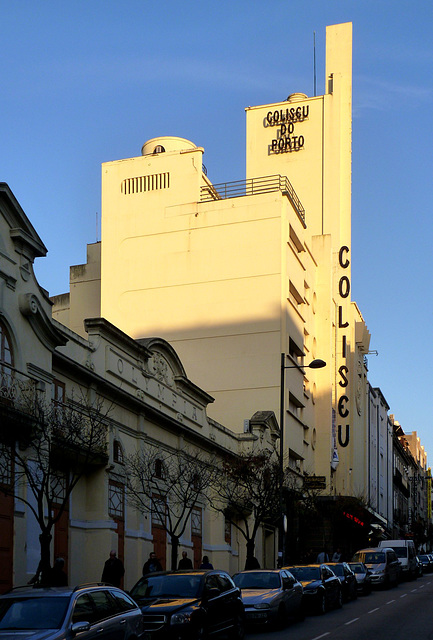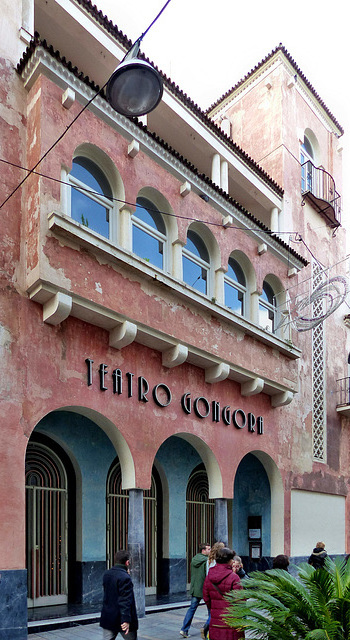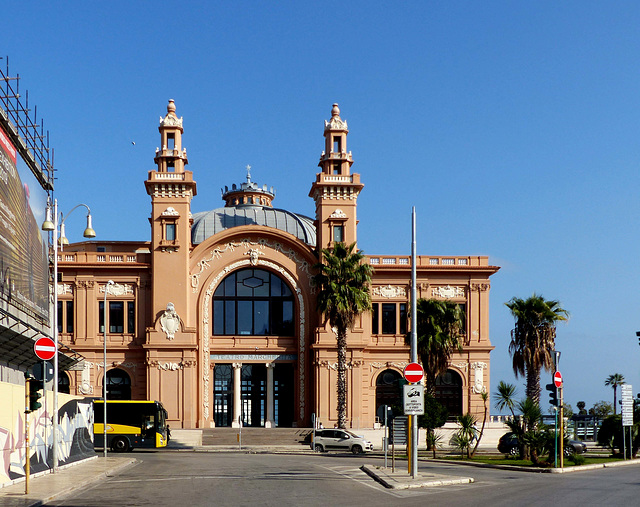
Cinemas
Cinemas, theaters, bingo halls...
Limoges - Lido
The city was founded as Augustoritum by the Romans, around 10 BC. Later it was "renamed" after the tribe of the Lemovices whose chief town it was.
Limoges was evangelized by Saint Martial, who came to the city around 250. Starting from the construction of the Abbey of St. Martial in the 9th century, the settlement grew around the tomb of the saint.
Starting from the 11th century, thanks to the presence of the Abbey of St. Martial and its large library, Limoges became a flourishing artistic centre. It was home to an important school of medieval music composition. In the 13th century, at the peak of its splendour, central Limoges consisted of two fortified settlements.
In 1370 during the Hundred Years War, Limoges was occupied by Edward, the Black Prince, who massacred some 300 residents with another members of the garrison.
The Lido Limoge is a nice cinema. The Lido in Paris is much better known for sure.
Verona - Astra
It looks like the former cinema Astra is closed for ever.
The building is "for sale".
Clermont-de-l'Oise - Salle Paul Lebrun
The elegant "Salle Paul Lebrun" from 1912 is now home of the "Cinéma du Clermontois".
Porto - Coliseu do Porto
Porto is with a population of about 250.000 the largest city in Northern Portugal. In "Greater Porto", the metropolitan area, live even more than 1.7 million people.
The historical center of Porto was proclaimed a World Heritage Site by UNESCO in 1996. Port wine is named after Porto, since the cellars of Vila Nova de Gaia on the southern banks of the river Douro are the centers for packaging, transport and export of the fortified wine. Some years ago I had been here for a couple of days before I started the "Camino Portugues" here.
The inner city of Porto hosts two stunning art deco buildings. Located just opposited the "Garagem Passos Manuel" (previous upload) is the "Coliseu do Porto". After an older concert hall had been demolished, the erection of the "Coliseu do Porto" started in 1938. The new building opened in December 1941. In 1971 the old concert hall was transformed into a cinema. After a fire had destroyed the stage and principal hall, the venue wsa reopned end of 1996.
www.coliseu.pt/
Aubenas - Cinema Palace
The ownership of the settlement was disputed between the bishops of Le Puy and the bishops of Viviers for centuries, as both wanted to build a stronghold here. Finally the bishops of Le Puy suceeded and transferred the possession in 1084 to the family of Baron de Montlaur. They stayed here upto 1441 and built the castle with a dungeon and two large round towers.
Later the town converted to Protestantism. In the first half of the 17th century 500 Corsican soldiers were stationed here with for mission to lead the heretics to Mass every Sunday. In 1629 Aubenas und the surrounding area were "converted". Today Aubenas has a population about 12.000. Catholics, Protestants, Moslems...
Once upon a time ...when cinemas still were palaces, there were no DCDs, downloads, streamings, not even TVs.
Córdoba - Teatro Gongora
Córdoba was captured by King Ferdinand III of Castile in 1236, after a siege of several months. The city declined over the next centuries and was partly destroyed and looted by French troops in 1808 during the Peninsular War.
Today Córdoba is a thriving city with a population of more than 300.000. The "Teatro Gongora" was built 1929 - 1932 and once was a cinema.
teatrocordoba.es/recintos/teatro-gongora
Palermo - Kursaal Bingo
Sicily, the largest Mediterranean island, has a long history, that starts around 8000 BC, but later there were Phoenician, Carthaginian, Greek and Roman periods. After the Roman Empire had fallen apart the Vandals tried to take over the island but failed. Finally, the Ostrogoths took possession.
Mid of the 6th century Sicily was conquered by troops of the Byzantine Empire. After the advent of Islam, Sicily got attacked by the Arab forces. Raids seeking loot continued until the mid-8th century.
A Muslim army was sent to the island in 827 but met with much resistance. So it took a century to conquer it and even later revolts constantly occurred
In 1038 the Byzantines invaded the island supported by Norman mercenaries, led by Roger. In 1072, after the siege of Palermo, most of Sicily was under Norman control. Roger´s son Roger II raised the status +of the island to a kingdom in 1130. During this period, the Kingdom of Sicily was prosperous and powerful,
The court of Roger II became melting out of culture from Europe and the Middle East. This attracted scholars, scientists, artists, and artisans. Muslims, Jews, Greeks, Lombards, and Normans cooperated and created some extraordinary buildings.
In 1186 the last descendant of Roger, Constance of Sicily married Emperor Henry VI, the second son of Barbarossa. So the crown of Sicily was passed on to the Hohenstaufen Dynasty. Frederick II, the only son of Constance, was crowned King of Sicily at the age of four in 1198. He became "Stupor Mundi", one of the greatest and most cultured men of the Middle Ages.
Palermo, founded in 734 BC by the Phoenicians, became a possession of Carthage and later was part of the Roman Empire. From 831 to 1072 the city was under Arab rule. Following the Norman conquest, Palermo became the capital of a new Kingdom of Sicily and the capital of the Holy Roman Empire under Emperor Frederick II and King Conrad IV.
-
The "Teatro Nazionale Biondo" (written over the front) was inaugurated in 1914. It was designed for the Biondo-Brothers comprising a cinema, a garden, a cafeteria and a restaurant.
Later under the name "Kursaal Bingo" it was used as bingo- and gambling hall.
Berlin - Renaissance Theater
Berlin is the capital and largest city of Germany. The city is one of Germany's 16 federal states.
The first records of towns in the area of present-day Berlin date from the late 12th century. The central part of Berlin can be traced back to two towns. Cölln on the Fischerinsel is first mentioned in 1237 and Berlin, across the river Spree in 1244. The two towns over time formed close economic and social ties, and profited from the staple right on the two important trade routes Via Imperii and from Bruges to Novgorod.
In 1415, Frederick I became the elector of the Margraviate of Brandenburg. His successors established Berlin-Cölln as capital of the margraviate, and subsequent members of the Hohenzollern family ruled in Berlin until 1918, first as electors of Brandenburg, then as kings of Prussia, and eventually as German emperors.
The Thirty Years' War between 1618 and 1648 devastated Berlin. The city lost half of its population. Frederick William, known as the "Grosse Kurfürst" initiated a policy of promoting immigration and religious tolerance from 1640 on. In 1685, Frederick William offered asylum to the Huguenots. By 1700, approximately 30 percent of Berlin's residents were French Huguenots. Other immigrants came from Bohemia and Poland.
The Industrial Revolution transformed Berlin during the 19th century; the city's economy and population expanded dramatically, and it became the main railway hub and economic centre of Germany. Additional suburbs soon developed and increased the area and population of Berlin. In 1871, Berlin became capital of the newly founded German Empire.
In 1933 the Nazi Party came to power. After the "Kristallnacht" progrom in 1938, thousands of the city's Jews were imprisoned in the nearby Sachsenhausen concentration camp. Starting in 1943, many were shipped to death camps, such as Auschwitz.
During World War II, large parts of Berlin were destroyed by Allied air raids and the 1945 Battle of Berlin. Around 125,000 civilians were killed. After the end of WWII , by Berlin received large numbers of refugees from the Eastern provinces. The victorious powers divided the city into four sectors, analogous to the occupation zones into which Germany was divided. The sectors of the Western Allies formed West Berlin, while the Soviet sector formed East Berlin.
The Berlin Wall was a barrier that divided the city from 1961 to 1989, when it fell. In October 1990, the German reunification process was formally finished.
-
The Renaissance Theatre at the corner Knesebeckstrasse / Hardenberstrasse is a listed building. It is claimed, that this is the last surviving art-deco theatre in Europe. Originally erected in 1902 as a "Corporation House", that already in 1919 housed a cinema. Here the Renaissance-Theater started in 1922. Architect Oskar Kaufmann converted the building into a theatre in the mid-1920s. It was reopened in 1927.
www.renaissance-theater.de/
Bari - Teatro Margherita
Bari was an early settlement and passed under Roman rule in the 3rd century BC. It developed strategic significance as the point of junction between the coast road and the Via Traiana and as a port for eastward trade. The first bishop of Bari was Gervasius who is known from the Council of Sardica in 347.
After the decline of the Roman Empire, the town was devasted and taken by Alaric´s Visigothic troops, then was under Lombardian rule, before the Byzantines took over. In 755 it was conquered by Pepin the Short (Charlemagne´s father) and from 847 on it was an Islamic Emirate. The Byzantine fleet returned in 871 and since 885 Bari ws the residence of the local Byzantine governor.
Following a three-year siege, Bari was captured by Robert Guiscard in 1071. After the relics of Saint Nicholas, which were surreptitiously brought from Myra in Lycia (Byzantine territory), arrived in Bari, the Basilica di San Nicola was founded in 1087. This attracted pilgrims, whose encouragement and care became central to the economy of Bari. Pope Urban II consecrated the Basilica in 1089. In 1096 a crusader army embarked in the port of Bari for the First Crusade.
After the murder of archbishop Griso in 1117 a civil war broke our and the control was seized by Grimoald Alferanites, a native Lombard, in opposition to the Normans. He later did homage to Roger II of Sicily, but rebelled and was defeated in 1132.
In 1155 the city's inhabitants rebelled again against the Normans and negotiated with the Byzantines. As a retaliatory action, William I of Sicily (aka William the Wicked") had the city destroyed except for the cathedral and the Basilica of St. Nicola in the following year.
Baro recovered and had it´s heydays under Frederick II. When he returned from his crusade after 1229, the city gates were locked so he had to use force to gain entry. Therefore, he probably had the fort built in 1233 to keep the city in check. On the other hand, he granted the city generous trade privileges and left it the leading role in the region.
Napoleon´s brother in law Joachim Murat, then King of Naples, ordered the building in 1808 of a new section of the city, laid out on a rationalist grid plan, which bears his name today as the Murattiano
Located at the edge of this area area is the Teatro Margherita. The first theather, named "Margherita Variety", was a wooden building, that burnt down, after having been only one year in business, in 1911.
The structure of the "Teatro Margherita" that was erected then, was the first building built in Bari in reinforced concrete, and unique in Europe for its particular construction on stilts. Being entirely surrounded by water, the theater was connected to the mainland by a pier .
The inauguration of the theater, named "Kursaal Margherita" took place in 1914. Later it housed the Historical Museum in its halls and was used as a cinema until 1979. It was purchased by the state and was subject to static restoration and restoration of the external facades until 2009. It was converted into the first museum complex of contemporary arts in the Apulian capital, the "BAC", that opened in 2018.
Jump to top
RSS feed- Latest items - Subscribe to the latest items added to this album
- ipernity © 2007-2024
- Help & Contact
|
Club news
|
About ipernity
|
History |
ipernity Club & Prices |
Guide of good conduct
Donate | Group guidelines | Privacy policy | Terms of use | Statutes | In memoria -
Facebook
Twitter










